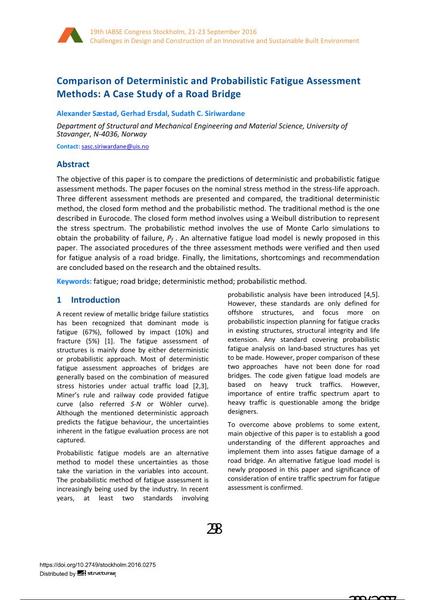Comparison of Deterministic and Probabilistic Fatigue Assessment Methods: A Case Study of a Road Bridge

|
|
|||||||||||
Détails bibliographiques
| Auteur(s): |
Alexander Sæstad
(Department of Structural and Mechanical Engineering and Material Science, University of Stavanger, N-4036, Norway)
Gerhad Ersdal (Department of Structural and Mechanical Engineering and Material Science, University of Stavanger, N-4036, Norway) Sudath Siriwardane (Department of Structural and Mechanical Engineering and Material Science, University of Stavanger, N-4036, Norway) |
||||
|---|---|---|---|---|---|
| Médium: | papier de conférence | ||||
| Langue(s): | anglais | ||||
| Conférence: | IABSE Congress: Challenges in Design and Construction of an Innovative and Sustainable Built Environment, Stockholm, Sweden, 21-23 September 2016 | ||||
| Publié dans: | IABSE Congress Stockholm, 2016 | ||||
|
|||||
| Page(s): | 298-306 | ||||
| Nombre total de pages (du PDF): | 9 | ||||
| Année: | 2016 | ||||
| DOI: | 10.2749/stockholm.2016.0275 | ||||
| Abstrait: |
The objective of this paper is to compare the predictions of deterministic and probabilistic fatigue assessment methods. The paper focuses on the nominal stress method in the stress-life approach. Three different assessment methods are presented and compared, the traditional deterministic method, the closed form method and the probabilistic method. The traditional method is the one described in Eurocode. The closed form method involves using a Weibull distribution to represent the stress spectrum. The probabilistic method involves the use of Monte Carlo simulations to obtain the probability of failure, Pf . An alternative fatigue load model is newly proposed in this paper. The associated procedures of the three assessment methods were verified and then used for fatigue analysis of a road bridge. Finally, the limitations, shortcomings and recommendation are concluded based on the research and the obtained results. |
||||
| Mots-clé: |
pont-route
|
||||

